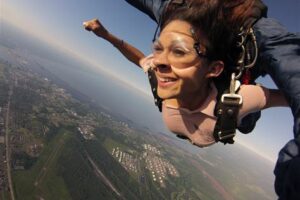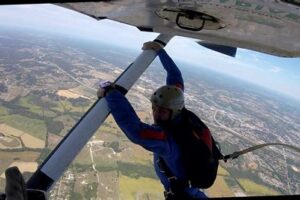Table of Contents
Curious about the speed at which skydivers plummet through the air? Discover how fast skydivers fall and experience the thrilling rush of freefalling at speeds of up to 120 miles per hour. Learn about the factors that influence their descent speed and the exhilarating sensation of defying gravity during this adrenaline-fueled adventure.
When it comes to the exhilarating sport of skydiving, one question that often comes to mind is: how fast do skydivers fall? The answer to this question is bound to captivate even the most cautious of readers. As the plane ascends to dizzying heights, anticipation builds, and adrenaline courses through the veins of these adventure-seekers. Once they step out into the vast expanse of the sky, gravity takes hold, propelling them towards the earth at breakneck speeds. But just how fast are they hurtling towards the ground? Let’s explore the fascinating world of skydiving and uncover the incredible velocities that skydivers reach during their thrilling descent.
The Science Behind Skydiving
Skydiving is an exhilarating sport that allows individuals to experience the thrill of freefalling through the sky. As skydivers jump out of an aircraft, they enter a state of freefall where they are not subject to any external forces other than gravity. This unique experience raises the question: How fast do skydivers fall?
Understanding the Role of Gravity
Gravity is the primary force at play when it comes to the speed at which skydivers fall. It is a force that pulls all objects towards the center of the Earth. Without any opposing forces, objects in freefall accelerate due to gravity.
The Concept of Terminal Velocity
While it may seem that skydivers would continue to accelerate indefinitely due to gravity, there is a limit to how fast they can fall. This limit is known as terminal velocity. Terminal velocity is the highest speed an object can reach when falling through the atmosphere, where the force of gravity is balanced by air resistance.
Factors Affecting Terminal Velocity
Several factors influence the terminal velocity of a skydiver. These include the skydiver’s body position, weight, and the density of the atmosphere. When a skydiver falls in a stable belly-to-earth position, they will reach a higher terminal velocity compared to when falling in a less stable position.
The Typical Terminal Velocity of a Skydiver
On average, a skydiver in a belly-to-earth position will reach a terminal velocity of around 120 mph (193 km/h). This speed is achieved after about 12 seconds of freefall. However, it is important to note that terminal velocity can vary depending on the factors mentioned earlier.
Duration of Freefall
The duration of freefall for a skydiver depends on the altitude from which they jump. For example, jumping from an altitude of 10,000 feet (3,048 meters) would provide a freefall time of approximately 30-40 seconds. However, this time can be increased or decreased depending on various factors such as the deployment of the parachute.
Acceleration During Freefall
During the initial moments of freefall, skydivers experience a rapid acceleration due to the force of gravity. The acceleration is approximately 9.8 meters per second squared (32 feet per second squared) and remains constant until they reach terminal velocity. This acceleration gives skydivers the feeling of weightlessness.
The Crucial Role of Parachute Deployment
Once a skydiver reaches terminal velocity, the deployment of the parachute becomes crucial for a safe landing. The parachute creates significant air resistance, reducing the speed of descent to a safe and manageable level. Without proper parachute deployment, the impact upon landing could be catastrophic.
Safety Measures in Skydiving
Skydiving is an extreme sport that requires adherence to strict safety measures. Skydivers undergo extensive training to learn proper body positioning, parachute deployment techniques, emergency procedures, and landing approaches. These measures are in place to ensure the safety of skydivers and reduce the risk of accidents.
The Thrill of Skydiving
Despite the inherent risks involved, skydiving continues to be a popular sport for adrenaline junkies and adventure enthusiasts. The sensation of freefalling through the sky at high speeds while enjoying panoramic views is an experience like no other. Understanding the science behind skydiving adds another layer of appreciation for the thrilling sport.
In conclusion, skydivers fall at varying speeds depending on several factors, including body position, weight, and atmospheric conditions. Terminal velocity plays a crucial role in determining the maximum speed a skydiver can reach during freefall. Adhering to safety measures and proper parachute deployment is essential for a safe landing. Skydiving remains an exhilarating sport that allows individuals to defy gravity and experience a unique rush of adrenaline.
How Fast Do Skydivers Fall?
Skydiving is an exhilarating adventure sport that involves parachuting from an aircraft. While performing this thrilling activity, it is natural to wonder about the speeds at which skydivers descend. This article delves into the factors influencing a skydiver’s descent speed and provides insights into the forces acting upon them.
Gravity and Terminal Velocity
Gravity plays a significant role in determining how fast skydivers fall. Initially, as a skydiver jumps out of the aircraft, they accelerate due to gravity. However, at a certain point, the acceleration plateaus, resulting in a constant velocity known as terminal velocity. This terminal velocity is influenced by several factors such as body position, weight, and air density.
Body Positioning
The positioning of a skydiver’s body greatly affects their speed during descent. By adjusting their body posture, skydivers can alter their drag coefficient and increase or decrease their descent speed. For instance, adopting a streamlined position with limbs close to the body helps reduce air resistance, providing a faster descent. Conversely, spreading limbs or creating a flat surface can increase resistance, slowing down the descent.
Weight
The weight of a skydiver is another critical determinant of descent speed. Heavier individuals experience greater forces of gravity, resulting in a faster fall compared to lighter individuals. However, it’s essential to note that reaching terminal velocity eventually equalizes the impact of weight differences among skydivers.
Air Density
Air density plays a significant role in how quickly a skydiver falls. At higher altitudes or in colder weather, the air density decreases, leading to a faster descent. Conversely, at lower altitudes or in warmer weather, denser air creates more resistance, reducing descent speed.
Canopy Deployment
Once a skydiver deploys their parachute or canopy, their descent speed is significantly reduced. Parachutes increase air resistance dramatically, decreasing the velocity at which the skydiver falls. The canopy size and shape also impact the descent speed, with larger canopies providing a slower descent.
Deceleration
As the landing approaches, skydivers engage in deceleration techniques to reduce their speed further. By utilizing flares, which are rapid increases in lift produced by the canopy, skydivers counteract their descent speed, allowing for a safe and gradual landing.
Safety Precautions
Skydivers must adhere to safety guidelines and regulations set by governing bodies to ensure their well-being during the entire experience. Proper training, the use of appropriate equipment, and following instructions from qualified instructors are imperative to minimize risks and ensure an enjoyable skydiving experience.
In conclusion, the speed at which skydivers fall is influenced by various factors such as body positioning, weight, air density, and the deployment of the parachute. Gravity and terminal velocity also play a crucial role in determining the descent speed. Understanding these factors and adhering to safety precautions are essential for every skydiver to have a safe and thrilling experience in the skies.
Point of View: How Fast Do Skydivers Fall
Skydiving is an exhilarating activity that allows individuals to experience the thrill of freefalling through the sky. One common question that arises when discussing skydiving is, How fast do skydivers fall? In this article, we will explore the factors that influence a skydiver’s descent speed and provide a professional perspective on the matter.
1. Terminal Velocity:
When a skydiver jumps from an aircraft, gravity pulls them towards the Earth, causing them to accelerate. However, as they gain speed, air resistance also comes into play. Eventually, a balance is reached between gravity and air resistance, resulting in a constant speed known as terminal velocity. The average terminal velocity for a skydiver in a belly-to-earth position is about 120 miles per hour (193 kilometers per hour).
2. Body Position:
The body position of a skydiver significantly affects their rate of descent. By adjusting their body posture, skydivers can alter their speed during freefall. A more streamlined position, with arms and legs close to the body, reduces air resistance and allows the skydiver to reach a higher speed. On the other hand, spreading out limbs increases air resistance and slows down the descent.
3. Altitude and Equipment:
The altitude at which a skydiver jumps also plays a role in their falling speed. As the skydiver descends, the air density increases, which results in greater air resistance. Consequently, the falling speed may decrease slightly as the skydiver approaches the ground. Additionally, the equipment worn by the skydiver, such as the parachute and jumpsuit, can affect the rate of descent.
4. Experience and Skill:
The experience and skill level of a skydiver can impact their falling speed to some extent. Experienced skydivers often have better body control and are more adept at adjusting their body posture to achieve their desired speed during freefall. They may also have a stronger understanding of how altitude and equipment can influence their descent, allowing them to make more precise adjustments.
Conclusion:
In conclusion, the speed at which skydivers fall is influenced by various factors including terminal velocity, body position, altitude, equipment, and the skill level of the skydiver. While the average terminal velocity for a belly-to-earth position is around 120 miles per hour, skydivers can adjust their speed by modifying their body posture and taking into account other elements. Overall, skydiving offers an incredible opportunity to experience the thrill of freefall while taking into consideration the necessary safety precautions and professional guidance.
Thank you for visiting our blog and taking the time to learn about the fascinating world of skydiving. In this article, we have explored the thrilling question of how fast skydivers fall and delved into the factors that affect their descent speed. We hope that this information has deepened your understanding of the science behind this exhilarating sport.
As we discussed earlier, the speed at which skydivers fall is influenced by several key factors. One of the primary determinants is body position. By adjusting their body posture during freefall, experienced skydivers can control their descent speed. By arching their back and extending their limbs, they can increase their surface area and slow down their fall. Conversely, by adopting a streamlined position, with their arms and legs close to their body, they can reduce air resistance and accelerate their descent.
Another important factor in skydiving speed is the weight of the individual. The force of gravity pulls objects with greater mass more strongly, causing them to fall faster. Therefore, a heavier skydiver will generally descend more quickly than a lighter one. However, it’s worth noting that this effect is not linear; as an object accelerates due to gravity, it eventually reaches a terminal velocity, where the force of gravity is balanced by air resistance. At this point, the speed of descent stabilizes, regardless of the person’s weight.
In conclusion, the speed at which skydivers fall is influenced by body position, weight, and the balance between gravity and air resistance. This thrilling sport combines the adrenaline rush of freefall with the precise control and technique required to achieve the desired descent speed. We hope that this article has provided you with valuable insights into the fascinating world of skydiving and its physics. Whether you are an avid skydiver or simply curious about the sport, we invite you to explore our blog further for more exciting content. Safe travels and blue skies!
Video How Fast Do Skydivers Fall
How Fast Do Skydivers Fall?
When it comes to the speed at which skydivers fall, there are several factors that come into play. Here are some commonly asked questions about how fast skydivers fall:
- What is the average speed of a skydiver?
- Can skydivers reach speeds faster than 120 mph?
- What is terminal velocity for a skydiver?
- How long does it take for a skydiver to reach terminal velocity?
- Can a skydiver exceed terminal velocity?
The average speed of a skydiver during freefall is around 120 miles per hour (193 kilometers per hour). This speed is achieved due to the force of gravity pulling the skydiver towards the Earth.
Yes, skydivers can reach speeds faster than 120 mph depending on their body position and other factors. By adjusting their body position to be more streamlined, skydivers can increase their speed and achieve what is known as terminal velocity.
Terminal velocity is the maximum speed at which an object, in this case a skydiver, falls through the air. For the average skydiver, terminal velocity is typically around 120 mph (193 kph). At this speed, the forces of gravity and air resistance are balanced, resulting in a constant velocity.
A skydiver usually reaches terminal velocity within about 12 seconds of freefall. During the initial moments of the jump, the skydiver accelerates until the resistance from air becomes equal to the force of gravity.
In rare cases, skydivers can exceed terminal velocity if they adopt a highly streamlined body position and dive headfirst towards the ground. However, this is extremely dangerous and not recommended without proper training and equipment.
It’s important to note that the speed at which skydivers fall can vary depending on factors such as body position, weight, altitude, and equipment. Professional skydivers undergo extensive training to ensure they have the skills and knowledge to safely control their descent speed.






